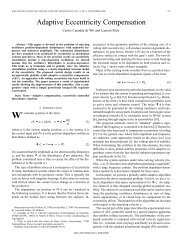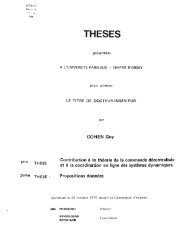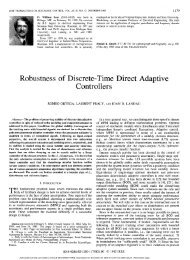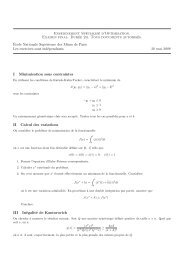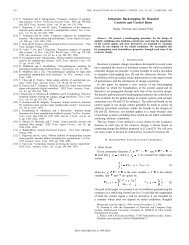Copyright © by SIAM. Unauthorized reproduction of this article is ...
Copyright © by SIAM. Unauthorized reproduction of this article is ...
Copyright © by SIAM. Unauthorized reproduction of this article is ...
Create successful ePaper yourself
Turn your PDF publications into a flip-book with our unique Google optimized e-Paper software.
1836 V. ANDRIEU, L. PRALY, AND A. ASTOLFITh<strong>is</strong> yields(5.9)⎧⎪⎨⎪⎩ddτ ̂X n = S n ̂Xn + B n φ n (ˆX n )) + K 1 (e 1 ) ,ddτ E 1 = S n E 1 + K 1 (e 1 )with E 1 =(e 1 ,...,e n ), ̂X n =(ˆX 1,...,ˆX n). The right-hand side <strong>of</strong> (5.9) <strong>is</strong> a vectorfield which <strong>is</strong> homogeneous in the bi-limit with weights (r 0 ,r 0 ), (r ∞ ,r ∞ ).Given d U > max j {r 0,j ,r ∞,j }, <strong>by</strong> applying Theorem 2.20 twice, we get two C 1 ,proper, and positive definite functions V : R n → R + and W : R n → R + such thatfor each i in {1,...,n}, the functions ∂V∂x iand ∂W∂e iare homogeneous in the bi-limit,with weights r 0 and r ∞ , degrees d U −r 0,i and d U −r ∞,i , and approximating functions∂V 0∂ ˆX j , ∂V∞∂ ˆX j(5.10)and ∂W0∂e jand for all E 1 ≠ 0,(5.11), ∂W∞∂e j. Moreover, for all ̂X n ≠ 0,∂V∂ ̂X (̂X n )∂V 0∂ ̂X(̂X n )n∂V ∞∂ ̂X(̂X n )n[]S n ̂Xn + B n φ n (̂X n ) < 0 ,[S n ̂Xn + B n φ n,0 (̂X n )]< 0 ,[]S n ̂Xn + B n φ n,∞ (̂X n ) < 0 ,∂W(E 1 )(S n E 1 + K 1 (e 1 )) < 0 ,∂E 1∂W 0(E 1 )(S n E 1 + K 1,0 (e 1 )) < 0 ,∂E 1∂W ∞(E 1 )(S n E 1 + K 1,∞ (e 1 )) < 0 .∂E 1Consider now the Lyapunov function candidate(5.12) U(ˆX n ,E 1 ) = V (ˆX n )+c W (E 1 ) ,where c <strong>is</strong> a positive real number to be specified. Letη(ˆX n ,E 1 )= ∂V ()∂ ̂X(̂X n ) S n ˆXn + B n φ n (ˆX n )+K 1 (e 1 )nγ(E 1 )=− ∂W∂E 1(E 1 )(S n E 1 + K 1 (e 1 )) .These two functions are continuous and homogeneous in the bi-limit with associatedtriples ((r 0 ,r 0 ),d U + d 0 ,η 0 ), ((r ∞ ,r ∞ ),d U + d ∞ ,η ∞ ) and ((r 0 ,r 0 ),d U + d 0 ,γ 0 ),((r ∞ ,r ∞ ),d U + d ∞ ,γ ∞ ), where γ 0 , γ ∞ and η 0 , η ∞ are continuous functions. Furthermore,<strong>by</strong> (5.11), γ(E 1 ) <strong>is</strong> negative definite. Hence, <strong>by</strong> (5.10), we have{} {}(ˆX n ,E 1 ) ∈ R 2n \{0} : γ(E 1 )=0 ⊆ (ˆX n ,E 1 ) ∈ R 2n : η(ˆX n ,E 1 ) < 0 ,{} {}(ˆX n ,E 1 ) ∈ R 2n \{0} : γ 0 (E 1 )=0 ⊆{}(ˆX n ,E 1 ) ∈ R 2n \{0} : γ ∞ (E 1 )=0 ⊆(ˆX n ,E 1 ) ∈ R 2n : η 0 (ˆX n ,E 1 ) < 0 ,{}(ˆX n ,E 1 ) ∈ R 2n : η ∞ (ˆX n ,E 1 ) < 0 .,<strong>Copyright</strong> © <strong>by</strong> <strong>SIAM</strong>. <strong>Unauthorized</strong> <strong>reproduction</strong> <strong>of</strong> <strong>th<strong>is</strong></strong> <strong>article</strong> <strong>is</strong> prohibited.




